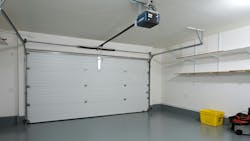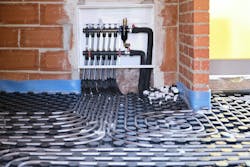6 Factors to Account for When Installing Radiant Heating in a Garage
While most hydronic radiant heating system installations are routine, contractors shouldn’t expect everything to go according to plan. Sometimes, client requests, local climate conditions and building types necessitate extra planning.
Here are six special factors they should consider.
1. Heat Loss in Cold Climates
Naturally, heat gain and loss determination is a critical factor to account for when installing hydronic heating in garages since they often have multiple exterior walls. If the client lives in an especially cold climate, overlooking its importance can pose issues. Contractors should carefully calculate it by considering cross-linked polyethylene (PEX) tubing spacing and length.
Designing a PEX tubing layout in a particularly cold climate can be challenging, especially if the client has sloped floors. While hydronic heating systems are up to 30% more energy efficient than forced air, excessive loops and fittings can make them inefficient. Long pipes reduce water pressure, resulting in uneven heat distribution despite higher energy consumption.
2. Price Sensitivity
Residential hydronic underfloor heating is becoming increasingly popular primarily due to the general public’s growing awareness of its heightened energy efficiency and cost savings. Experts expect it will achieve a 6.1% compound annual growth rate from 2023 to 2032, raising its market value from $2.5 billion to $4.5 billion.
As the popularity of residential hydronic heating systems increases, one of the most common factors contractors must consider is budget-related requests. Since these clients are driven by promises of cost-effective installation and a generous return on investment, they will be very sensitive to potential or perceived efficiency losses.
In these scenarios, contractors should prioritize the systems’ energy efficiency, optimizing it in any way possible. Since garages are notorious for high heat loss, additional interior temperature regulation may be necessary. Putting in this extra effort for budget-sensitive clients may increase the chances of securing higher satisfaction rates.
Contractors should consider insulation because it mitigates heat loss, indirectly improving their system’s efficiency. For example, an insulated garage door can lower electricity expenses by improving heat retention and temperature management. This addition can save technicians from revisiting clients to fix frozen hydronic components.
Radiant underfloor heating hydronic manifold with flexible tubing.
3. Year-Round Use
Clients looking to use their garage year-round as a home office or a gym need the space to maintain a comfortable temperature regardless of the season or sudden temperature fluctuations. Contractors should account for these special situations by optimizing PEX tubing spacing and thermostat placement.
Although hydronic heating is known for its even heat distribution, common installation mistakes can significantly inhibit its effectiveness. For instance, improper thermostat placement can cause systems to kick on in bursts, straining to generate heat as fast as possible instead of incrementally adjusting its output to maintain a consistent temperature.
When clients plan to use their garage year-round, a thermostat that incorrectly gauges the room temperature is unacceptable. Contractors should proactively prevent any such mistakes by moving it away from drafts, direct sunlight and other heat sources. They should also consider the effect the temperature differential between external and interior walls can have.
4. Humidity-Sensitive Storage
Many people use their garage to store items sensitive to humidity. Although hydronic systems generally don’t introduce moisture—unlike forced air—improper installation can lead to leaks and temperature differentials. Contractors must account for situations where clients have underfloor heating to preserve a classic car or other kinds of valuable automobiles.
In this scenario, they must avoid introducing moisture into the space. The temperature differential in an uninsulated garage can easily freeze condensation on sensitive components, which can damage internal mechanisms and shorten a vehicle’s lifespan significantly. An effective installation should prioritize humidity management.
Even without installation mistakes, a hydronic heating system can indirectly impact humidity if the client has an airtight home—especially if they live in a particularly humid climate or have poor air quality. Contractors should account for this factor by considering a heat recovery ventilation (HRV) unit.
Unlike forced-air systems, a hydronic heating system doesn’t require air exchange. However, it can still benefit from the addition of an HRV. These systems can prevent 50%-75% heat loss, manage humidity levels and improve air quality. These considerations are essential in scenarios where the client plans to preserve valuable belongings like a classic car.
5. Preference for Sustainability
For some clients, sustainability is the most important factor in the installation of a hydronic heating system. Considering the general public shows an increasing preference for energy-saving services and products as environmental awareness rises, this may become a common occurrence soon. Contractors should prepare for these situations by prioritizing efficiency.
While professionals installing systems can make decisions to increase energy efficiency—like insulating or optimizing tubing layout—the responsibility for making marked improvements falls to system designers.
System designers’ work has the potential to be most impactful. For example, some projects experienced a 60% reduction in power consumption after upgrading their pumps to be more energy efficient. The novel innovations they develop have a better chance of significantly affecting hydronic components’ sustainability.
6. Suspended Garage Slabs
While suspended garage slabs are relatively uncommon in many countries, contractors will likely encounter one at some point in their careers. Due to their construction, heat diffuses throughout the concrete evenly instead of rising naturally.
A standard concrete floor’s thermal mass means it can take hours—even days—to reach the desired temperature after a manual thermostat adjustment. Suspended slabs often perform even worse because underfloor heating won’t rise adequately. Contractors should account for this factor and plan accordingly.
Although placing hydronic components on top of the suspended slab with some form of insulation requires a more significant upfront investment, it can prevent up to 90% of heat loss over a building’s lifetime. Contractors must account for material type and thermal mass in these scenarios.
Approach Every Installation Like It’s the First
As hydronic heating increases in popularity, contractors will likely need to meet more specific requests and requirements. Proactive strategic workarounds and system redesigns will be crucial in these scenarios to increase energy efficiency while lowering power consumption and heat loss.
Oscar Collins is the Editor-in-Chief at Modded. Follow him on Twitter @TModded for frequent updates on his work.

